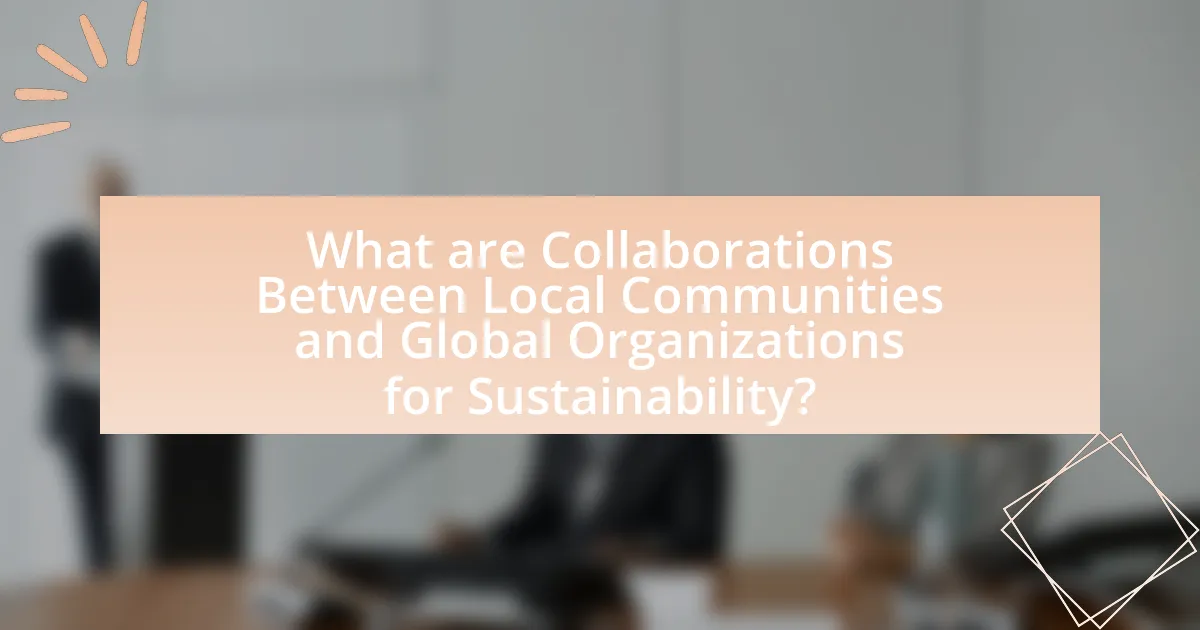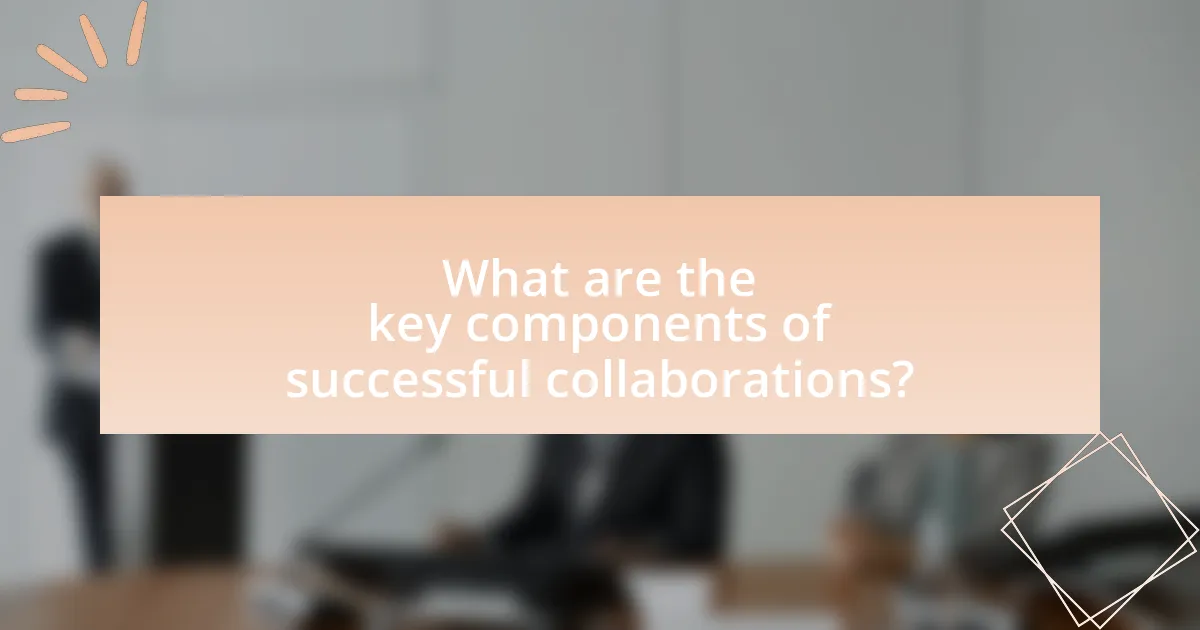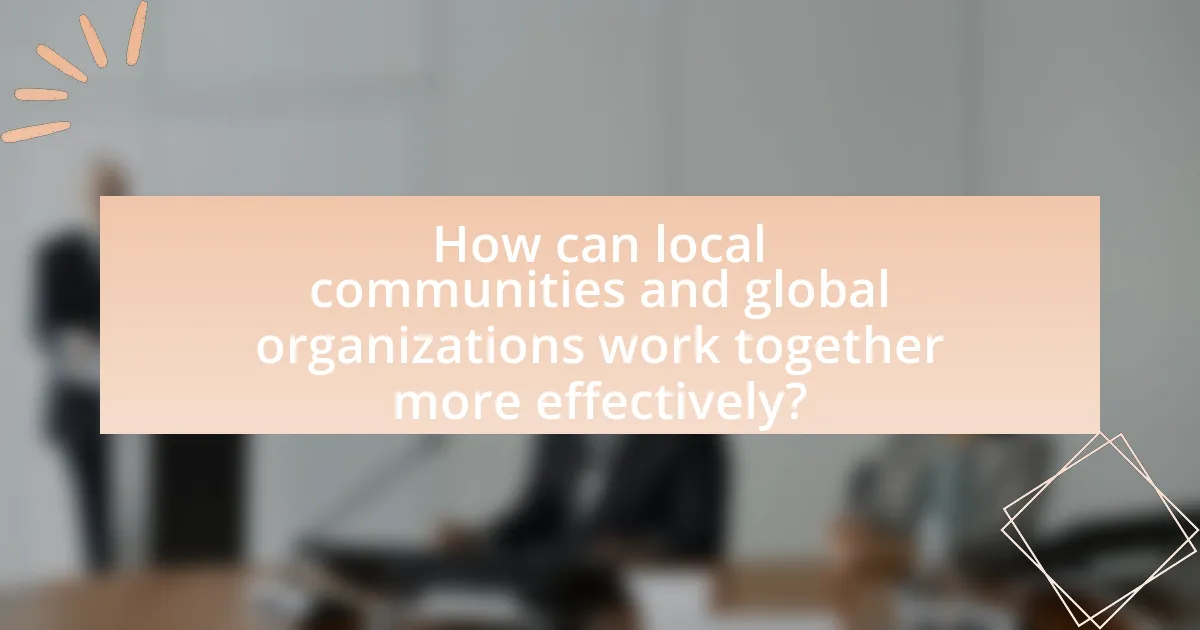Collaborations between local communities and global organizations for sustainability are partnerships aimed at addressing environmental, social, and economic challenges through the integration of local knowledge and global expertise. These collaborations evolve through mutual interests, shared goals, and continuous communication, with local communities providing cultural insights and grassroots support while global organizations offer resources and technical assistance. Successful partnerships enhance sustainability outcomes by addressing specific challenges such as deforestation and water scarcity, promoting social equity, and fostering economic development. Key components for effective collaboration include clear communication, mutual respect, and trust, while challenges such as differing priorities and cultural differences must be navigated to achieve impactful results.

What are Collaborations Between Local Communities and Global Organizations for Sustainability?
Collaborations between local communities and global organizations for sustainability involve partnerships aimed at addressing environmental, social, and economic challenges. These collaborations often leverage local knowledge and resources while integrating global expertise and funding to implement sustainable practices. For instance, initiatives like the United Nations’ Sustainable Development Goals encourage local communities to engage with global entities to achieve targets such as clean water access and climate action. Evidence of successful collaborations includes projects like the Global Environment Facility, which funds local projects that align with global sustainability objectives, demonstrating the effectiveness of such partnerships in fostering sustainable development.
How do these collaborations form and develop?
Collaborations between local communities and global organizations for sustainability form and develop through mutual interests and shared goals. Initially, local communities identify specific sustainability challenges, such as resource management or environmental conservation, which attract the attention of global organizations seeking to implement their sustainability agendas. These organizations often provide resources, expertise, and funding, while local communities contribute local knowledge and cultural insights, creating a symbiotic relationship.
As these collaborations progress, they typically evolve through continuous communication, joint project planning, and adaptive management strategies that respond to changing circumstances and feedback. For instance, the United Nations Development Programme (UNDP) has successfully partnered with local communities in various countries to implement sustainable development projects, demonstrating how structured frameworks can facilitate effective collaboration. This ongoing interaction fosters trust and strengthens partnerships, ultimately leading to more impactful and sustainable outcomes.
What roles do local communities play in these collaborations?
Local communities serve as essential partners in collaborations with global organizations for sustainability by providing local knowledge, cultural insights, and grassroots support. Their involvement ensures that sustainability initiatives are contextually relevant and culturally appropriate, which enhances the effectiveness of these projects. For instance, local communities often contribute traditional ecological knowledge that informs sustainable practices, as seen in various conservation efforts worldwide. Additionally, they mobilize community engagement and foster local ownership of sustainability initiatives, which can lead to higher success rates and long-term sustainability outcomes.
What roles do global organizations play in these collaborations?
Global organizations play a crucial role in collaborations with local communities for sustainability by providing resources, expertise, and a platform for knowledge exchange. These organizations often facilitate funding and technical support, enabling local initiatives to scale and implement sustainable practices effectively. For instance, the United Nations Development Programme (UNDP) partners with local entities to promote sustainable development goals, demonstrating how global frameworks can enhance local efforts. Additionally, global organizations help in capacity building by offering training and best practices, which empower communities to adopt sustainable methods. This collaborative approach not only strengthens local capacities but also aligns community efforts with international sustainability standards, ensuring a more cohesive and impactful outcome.
Why are these collaborations important for sustainability?
Collaborations between local communities and global organizations are crucial for sustainability because they leverage local knowledge and resources while integrating global expertise and funding. These partnerships enable the development of tailored solutions that address specific environmental and social challenges faced by communities, enhancing the effectiveness of sustainability initiatives. For instance, the United Nations’ Sustainable Development Goals emphasize the importance of local engagement in achieving global sustainability targets, highlighting that local insights can lead to more relevant and impactful strategies.
What environmental challenges do they address?
Collaborations between local communities and global organizations address several environmental challenges, including deforestation, water scarcity, and biodiversity loss. These partnerships often focus on sustainable land management practices that reduce deforestation rates, as evidenced by initiatives like the REDD+ program, which aims to reduce emissions from deforestation and forest degradation. Additionally, they tackle water scarcity through community-led conservation projects that promote efficient water use and management, supported by organizations such as the World Wildlife Fund. Furthermore, these collaborations work to protect biodiversity by implementing conservation strategies that involve local stakeholders, ensuring that both ecological and community needs are met.
How do they contribute to social equity and economic development?
Collaborations between local communities and global organizations contribute to social equity and economic development by fostering inclusive participation and resource sharing. These partnerships enable marginalized groups to access funding, training, and technology, which enhances their economic opportunities. For instance, initiatives like the United Nations Sustainable Development Goals emphasize local engagement, resulting in improved livelihoods and reduced inequalities. According to a report by the World Bank, community-driven development projects have shown a 20% increase in household income in participating areas, demonstrating the tangible benefits of such collaborations.

What are the key components of successful collaborations?
The key components of successful collaborations include clear communication, mutual respect, shared goals, and trust among participants. Clear communication ensures that all parties understand their roles and responsibilities, which is essential for effective teamwork. Mutual respect fosters a positive environment where diverse perspectives are valued, enhancing creativity and problem-solving. Shared goals align the efforts of all collaborators, driving collective action towards common objectives. Trust builds a foundation for open dialogue and risk-taking, which are crucial for innovation and long-term partnerships. Research indicates that collaborations with these components are more likely to achieve sustainable outcomes, as evidenced by successful initiatives documented in case studies of community and organizational partnerships.
What strategies enhance collaboration effectiveness?
Effective collaboration can be enhanced through clear communication, defined roles, and mutual respect among participants. Clear communication ensures that all parties understand objectives and expectations, which minimizes misunderstandings and aligns efforts. Defined roles help participants know their responsibilities, fostering accountability and efficiency. Mutual respect builds trust, encouraging open dialogue and the sharing of diverse perspectives, which is crucial for innovative solutions in sustainability initiatives. Research indicates that organizations with strong collaborative cultures are 5 times more likely to be high-performing, highlighting the importance of these strategies in achieving successful outcomes.
How does communication impact collaboration outcomes?
Effective communication significantly enhances collaboration outcomes by fostering clarity, trust, and shared understanding among participants. When stakeholders engage in open dialogue, they are more likely to align their goals and expectations, which is crucial for successful partnerships. Research indicates that organizations with strong communication practices experience a 25% increase in project success rates, as clear communication reduces misunderstandings and conflicts. Furthermore, effective communication facilitates the exchange of ideas and resources, enabling collaborative efforts to be more innovative and responsive to challenges. Thus, the quality of communication directly correlates with the effectiveness and sustainability of collaborative initiatives.
What role does trust play in these partnerships?
Trust is essential in partnerships between local communities and global organizations for sustainability, as it fosters collaboration and effective communication. When trust exists, local communities are more likely to share valuable insights and resources, while global organizations can engage authentically and implement initiatives that align with community needs. Research indicates that trust enhances the likelihood of successful project outcomes, as evidenced by case studies where high levels of trust led to increased participation and resource sharing, ultimately resulting in more sustainable practices and long-term benefits for both parties.
What challenges do these collaborations face?
Collaborations between local communities and global organizations for sustainability face several challenges, including differing priorities, communication barriers, and resource allocation issues. These challenges arise because local communities often prioritize immediate needs, such as economic stability and social welfare, while global organizations may focus on broader sustainability goals, leading to misalignment. Communication barriers can stem from cultural differences and varying levels of understanding regarding sustainability concepts, which can hinder effective collaboration. Additionally, resource allocation issues occur when funding and support from global organizations do not adequately meet the specific needs of local communities, resulting in ineffective implementation of sustainability initiatives.
How do cultural differences affect collaboration?
Cultural differences significantly affect collaboration by influencing communication styles, decision-making processes, and conflict resolution approaches. For instance, in cultures with high-context communication, such as Japan, non-verbal cues and implicit messages are crucial, while low-context cultures, like the United States, prioritize direct and explicit communication. This divergence can lead to misunderstandings and misinterpretations during collaborative efforts. Additionally, research by Hofstede indicates that cultural dimensions, such as individualism versus collectivism, impact how teams approach tasks and responsibilities, affecting overall collaboration effectiveness. In collaborative projects between local communities and global organizations, recognizing and adapting to these cultural differences is essential for achieving sustainable outcomes.
What are the common barriers to effective collaboration?
Common barriers to effective collaboration include communication issues, differing goals, lack of trust, and resource constraints. Communication issues arise when stakeholders fail to share information clearly, leading to misunderstandings. Differing goals can create conflicts, as local communities and global organizations may prioritize different outcomes. Lack of trust undermines collaboration, often stemming from past negative experiences or perceived power imbalances. Resource constraints, such as limited funding or personnel, hinder the ability to engage effectively. These barriers have been documented in various studies, including the “Collaborative Governance: A New Approach to Public Management” by Chris Ansell and Alison Gash, which highlights the importance of addressing these challenges for successful partnerships.

How can local communities and global organizations work together more effectively?
Local communities and global organizations can work together more effectively by establishing clear communication channels and aligning their goals towards sustainable development. Effective collaboration requires local communities to articulate their needs and priorities, while global organizations must be willing to listen and adapt their strategies accordingly. For instance, the United Nations’ Sustainable Development Goals (SDGs) emphasize the importance of local engagement in achieving global objectives, demonstrating that successful partnerships depend on mutual understanding and respect for local contexts. Additionally, case studies, such as the collaboration between the World Wildlife Fund and local fishing communities, show that integrating local knowledge into global initiatives leads to more sustainable outcomes.
What best practices can be adopted for better collaboration?
To enhance collaboration between local communities and global organizations for sustainability, establishing clear communication channels is essential. Effective communication fosters understanding and alignment of goals, which is critical for successful partnerships. Research indicates that organizations that prioritize transparent communication experience a 25% increase in project success rates. Additionally, involving local stakeholders in decision-making processes ensures that their insights and needs are addressed, leading to more relevant and sustainable outcomes. Engaging in regular feedback loops allows for continuous improvement and adaptation of strategies, further strengthening collaboration.
How can technology facilitate these partnerships?
Technology can facilitate partnerships between local communities and global organizations for sustainability by enabling efficient communication and data sharing. Digital platforms allow for real-time collaboration, ensuring that stakeholders can exchange information quickly and effectively. For instance, tools like video conferencing and project management software enhance coordination among diverse groups, leading to more informed decision-making. Additionally, data analytics can provide insights into local needs and environmental conditions, allowing organizations to tailor their initiatives to specific community contexts. Research shows that technology-driven collaborations can increase project success rates by up to 30%, demonstrating its critical role in fostering effective partnerships for sustainability.
What are the benefits of shared resources and knowledge?
Shared resources and knowledge enhance collaboration, leading to increased efficiency and innovation. When local communities and global organizations share resources, they can reduce costs and avoid duplication of efforts, which is crucial for sustainability initiatives. For instance, a study by the United Nations Development Programme highlights that collaborative resource sharing can lead to a 30% reduction in project costs. Furthermore, shared knowledge fosters best practices and accelerates learning, enabling communities to implement effective solutions more rapidly. This synergy not only strengthens community resilience but also contributes to achieving broader sustainability goals, as evidenced by successful partnerships documented in various sustainability reports.
What are some successful examples of these collaborations?
Successful examples of collaborations between local communities and global organizations for sustainability include the partnership between the United Nations Development Programme (UNDP) and local farmers in Kenya, which focused on sustainable agricultural practices. This collaboration led to a 30% increase in crop yields and improved food security for the community. Another example is the collaboration between the World Wildlife Fund (WWF) and indigenous communities in the Amazon rainforest, which resulted in the establishment of protected areas that conserve biodiversity while respecting indigenous rights. This initiative has successfully preserved over 1 million hectares of rainforest. Additionally, the Global Environment Facility (GEF) partnered with local communities in Madagascar to implement sustainable fishing practices, which increased fish populations by 50% and enhanced local livelihoods. These examples demonstrate the effectiveness of collaborative efforts in achieving sustainability goals.
How have specific projects made a difference in sustainability?
Specific projects have made a significant difference in sustainability by implementing community-driven initiatives that reduce environmental impact and promote resource conservation. For example, the “Green City” project in Medellín, Colombia, transformed urban spaces by integrating green roofs and public parks, which improved air quality and reduced urban heat. This initiative led to a 30% increase in green areas, demonstrating a direct correlation between urban greening and enhanced biodiversity. Additionally, the “Waste to Energy” project in India converted agricultural waste into bioenergy, reducing landfill use by 50% and providing clean energy to local communities. These projects exemplify how targeted efforts can yield measurable sustainability outcomes, benefiting both local ecosystems and communities.
What lessons can be learned from these successful collaborations?
Successful collaborations between local communities and global organizations for sustainability demonstrate the importance of mutual respect and understanding. These partnerships thrive when both parties recognize and value each other’s strengths, leading to more effective solutions. For instance, the collaboration between the United Nations Development Programme and local farmers in Kenya resulted in sustainable agricultural practices that increased crop yields by 30%, showcasing how local knowledge can enhance global initiatives. Additionally, effective communication and shared goals are crucial; when stakeholders align their objectives, they can mobilize resources more efficiently, as seen in the partnership between the World Wildlife Fund and indigenous groups in the Amazon, which successfully protected vast areas of rainforest. These examples illustrate that successful collaborations hinge on respect, communication, and shared objectives, ultimately leading to sustainable outcomes.
What practical steps can communities and organizations take to initiate collaboration?
Communities and organizations can initiate collaboration by establishing clear communication channels and shared goals. Effective communication fosters understanding and trust, which are essential for collaboration. For instance, regular meetings and workshops can help stakeholders articulate their objectives and identify common interests. Additionally, creating a collaborative framework, such as a memorandum of understanding, can formalize the partnership and outline roles and responsibilities. Research shows that partnerships with defined structures lead to more successful outcomes, as evidenced by the 2018 study published in the Journal of Environmental Management, which found that structured collaborations significantly improved project effectiveness in sustainability initiatives.